Dubai
![]()
This article is about the city. For the emirate of the same name, see Dubai (emirate).
Dubai (Arabic دبي Dubayy) is the capital of the Emirate of Dubai and the largest city in the United Arab Emirates (UAE) on the Persian Gulf.
The city of Dubai (sometimes referred to as "Dubai City" or "Dubai City" to distinguish it from the emirate of Dubai) is home to approximately 85% of the emirate's population (3,103,000 residents as of mid-2018). An accurate census is complicated because of large fluctuations due to migration, as tens of thousands of residents are added annually as migrant workers or immigrants. Almost all of the emirate's economic, social, cultural and political life takes place in Dubai. Dubai has been one of the most visited cities in the world since 2013, with up to 14 million foreign tourists annually. In 2016, Dubai had 15.3 million visitors, ranking it 4th in the world. It also had the highest tourism revenue of any city at over $31 billion.
The city of Dubai is located on the northern edge of the Emirate of Dubai and is divided by the Dubai Creek, a bay of the Persian Gulf that is 100 to 1300 meters wide and about 14 kilometers long. In former times, the then independent cities of Deira on the north side and Bur Dubai on the south side were located here. Bridges are located somewhat away from the town centre; pedestrians are transported to the opposite side by small passenger ferries (Abras).
The city extends mainly to the south along Jumeirah Beach and Sheikh Zayed Road, as Dubai directly borders the emirate of Sharjah to the north.
Thanks to a decades-long construction boom, Dubai is the city with the world's highest number of skyscrapers over 300 metres high, as well as the world's tallest building (Burj Khalifa, 828 metres). Dubai is a global trade hub and has the world's third largest airport by passenger traffic (as of 2017) and the tenth largest port by container throughput (2018: 14.95 million TEUs). In a ranking of the world's most important financial centres, Dubai ranked 19th (as of 2018).
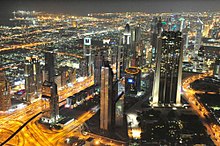
Dubai night aerial view
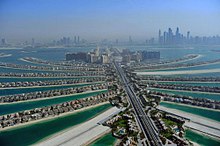
Palm Island "The Palm, Jumeirah"
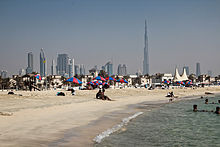
Beach in Jumeirah
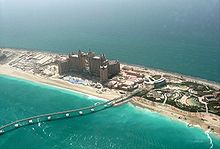
Luxury Hotel & Resort "Atlantis The Palm, Dubai"
Traffic
Long-distance traffic
Dubai International Airport (DXB) is the most important airport in the Middle East. It is located in the north of Deira, about 5 kilometers from Dubai Creek. In 2010, a new airport was opened in Dubai (near Jebel Ali), the Dubai World Central International Airport. With a maximum capacity of possibly 160 million passengers per year (as of the end of 2018), which is to be expanded in stages, this airport will initially only support Dubai International Airport. Dubai is the headquarters of the Emirate-owned airline Emirates.
Furthermore, Dubai has the most important transshipment point in the Persian Gulf in the artificially created seaport of Jebel Ali, with 92,513 million tons of transshipment (2005). Trend: strong increase, especially container throughput in connection with the huge free trade zones around Jebel Ali (2018: 14.95 million TEU). The highly automated Container Terminal 4 is due to come on stream at the end of 2019, while Terminal 1 will be closed for a makeover. Dubai is served by both commercial and passenger vessels. The latter are handled at the older Port Rashid, which is close to the city. The most important ferry connections run from there to Doha, Manama, Kuwait and Muscat. Still significant, though relatively declining, is regional "small" maritime traffic using traditional dhows from creek berths. It is mostly handled close to the coast with small cargoes (e.g. consumer goods) throughout the Persian Gulf, via Oman and Yemen to the central Red Sea, East Africa and Pakistan as well as western India up to about Goa with daring seafarers.
Dubai is connected to Abu Dhabi, Sharjah, Hatta and Al-Ain by highways.
City traffic
More than almost any other city in Asia, Dubai is a car city: in mid-2010, 1.022 million registered vehicles were reported for a population of around 1.8 million. Since most of the migrant workers do not own a vehicle, passenger cars are concentrated among individuals and families with middle or higher incomes; there are many vehicle owners with second and multiple vehicles. Road traffic in the dense, older part of Dubai is very heavy, congestion and prolonged periods of gridlock are the norm. At the petrol stations, there is mostly only valet service, as people do not want to let customers out of their air-conditioned cars due to the high temperatures.
The Roads and Transport Authority (RTA) is responsible for the construction of new roads as well as public transport.
To combat the increasingly dense motor vehicle traffic, the RTA introduced the Salik automated toll system on certain routes in July 2007. Each vehicle passing the toll roads and bridges requires a Salik sticker with a credit on the front window. The vehicles are registered via toll bridges and the toll (4 Dirham per trip) is debited electronically. The vehicle owners are informed via SMS shortly before their Salik account is used up.
Local public transport
In addition to buses, Dubai has a metro, a tram system and a monorail.
The local public transport is equipped with a dense bus line network, the use is inexpensive. A special feature are the 800 waiting rooms of the total of over 1000 bus stops, which were introduced at the beginning of 2008 and are air-conditioned to date (September 2010) with 22 degrees Celsius. The bus system has over 1300 modern vehicles, which travel around 300,000 route kilometres daily.
The Dubai Metro, which took four years to build and is operated without a driver, was partially opened in September 2009. The metro connects Dubai International Airport with the city center (red line), with a connection to Dubai World Central International Airport to follow after further expansion. The second line (green line), which runs centrally in Deira and Bur Dubai, opened in September 2011 with 16 new stations and 23 route kilometres. In autumn 2010, the transport authority reported that public transport accounted for eleven percent of total traffic.
The passenger transport in the narrower city center over the front Dubai Creek is due to the lack of city bridges with Abras, small wooden boats for up to about 20 people. During the day, an abra departs every few minutes, a trip takes less than 10 minutes and costs 1 dirham.
Not included in the RTA fare system is the Dubai Monorail, whose first spur line runs to The Palm, Jumeirah.
There is also the Dubai Trolley, a short, single-track tram with a vintage look, but built mainly as a tourist attraction. There are plans to extend the line and connect it to the general transport network.
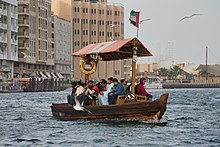
Abra over the Dubai Creek
Culture and sights
Skyscrapers
→ Main article: List of tallest buildings in Dubai
In the vicinity of Dubai (40 km radius), there were about 150 skyscrapers over 150 m high at the beginning of 2008, about 60 more skyscrapers over 200 m high and six skyscrapers over 300 m high. These are the Almas Tower at 360 m, the two Emirates Towers at 355 and 305 m respectively, the Rose Tower at 333 m, the Burj al Arab at 321 m and the tallest structure in the world, the Burj Khalifa at 828 m. About twenty more skyscrapers with a height of over 300 m are planned or under construction.
Theatre
The smaller Madinat Theater is located right next to the Burj al Arab. Concerts are performed here, the Dubai International Film Festival takes place here, but also opera or ballet performances such as Swan Lake or the Vienna Opera Ball in Dubai.
Furthermore there is the Streetwise Theater from London in the Crown Plaza Hotel.
Museums
At the entrance of the Dubai Creek - near the mouth - on a headland is the district Al Schindagha. Here in the north of Bur Dubai, the Heritage and Diving Village was built by the government in 1997. The museum village in the style of an Arab settlement is intended to convey the culture, history and tradition of Dubai to the visitor.
"Heritage Village"
Replicated in the original are stone houses from the mountain and desert regions, Bedouin tents, traditional "wind tower houses", market stalls, spice shops and many other attractions and ways of life of the inhabitants. Dubai residents also show interest in visiting these historic villages.
"Diving Village"
In the "pearl village", traditional souks, photo exhibitions about pearl fishing, dhows - some of them in original size - and a large water basin, in which diving techniques of the pearl fishermen are demonstrated, await the guest before this traditional occupation is completely forgotten.
Dubai Museum
The Dubai Museum is located near the old town in the former al-Fahidi Fort and offers an overview of the historical life in Dubai before the oil boom. Near the Dubai Museum there is a settlement of former Persian merchant houses that have been renovated and can be partially visited.
Trips
Many providers offer organized tours into the desert outside the city, if desired also with overnight stay in the tent.
Other sights
In the city center, these are mainly the Dubai Creek with the old Dhaus and the spice market, where spices from all over the world are sold. Numerous small jewelry shops are located in the gold market. This has old wooden facades and has a typical oriental atmosphere with the traders and load carriers. The more modern Souq al Bahar is located in Dubai Downtown next to the Dubai Mall. The Souq al Bahar and the Dubai Mall together with the Burj Khalifa form a triangle, in the middle of which the Dubai Fountains offer a water-light-music spectacle every evening. From there you can also see the luxury hotel "The Address".
On the south side of the creek is the renovated old town of Bur Dubai, the Old Souk ("old market"). West of it in front of the new port is the reconstruction of the pompous old ruler's palace with a museum.
The Palm Jumeirah is currently the only palm island in Dubai that can be visited. Worth seeing is the luxury hotel and resort Atlantis The Palm, Dubai, an imposing hotel building with the theme of the sunken city of Atlantis. Connected to the hotel complex is the Aquapark Aquaventure.
The large number of shopping malls represent an exclusive shopping paradise of Dubai. There are also numerous boutiques of noble brands of the fashion world. Classic shopping streets play a subordinate role: most shops are located in American-style malls. The largest shopping malls in the city are the Mall of the Emirates and the Dubai Mall. In addition, there are a number of others, such as the 'Ibn Battuta Mall' (Ibn Battuta = "son of Battuta"). It is divided into different countries and regions and decorated according to each country. It also has a lot of information about the different countries and the discoverer Ibn Battūta.
Jumeirah Beach Park is a beach park that is visited not only by tourists but also by Emiratis. Cameras and revealing swimwear are prohibited on the beach for religious reasons.
The Miracle Garden Dubai is the world's largest horizontal colorful flower garden with about 45 million blooming flowers. It is located outside the centers in the northwest.
Dubai is also known for its Emirates Golf Club, which hosts an annual PGA tournament (Dubai Desert Classic).
With the 1335-square-meter Palm Fountain, Dubai currently also has the largest fountain in the world, which found its way into the Guinness Book of Records as the "largest structure of its kind". According to Guinness, the fountains shoot 105 meters high and are illuminated by 3000 LED lights.

Fish Market
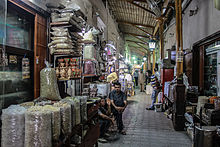
Souk
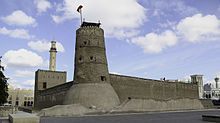
The al-Fahidi Fort in the centre of Dubai
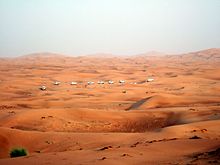
Guided desert tour in the Emirate of Dubai
Search within the encyclopedia